MARIANI’SVirtual
Gourmet
August 11, 2013
NEWSLETTER

THIS WEEK
CHICAGO,
Part One
by John Mariani
NEW
YORK CORNER
Stella 34
by John Mariani
NOTES
FROM THE WINE CELLAR
Jefferson Was Right About Virginia Wines
by John Mariani
❖❖❖
CHICAGO, Part One
by John Mariani
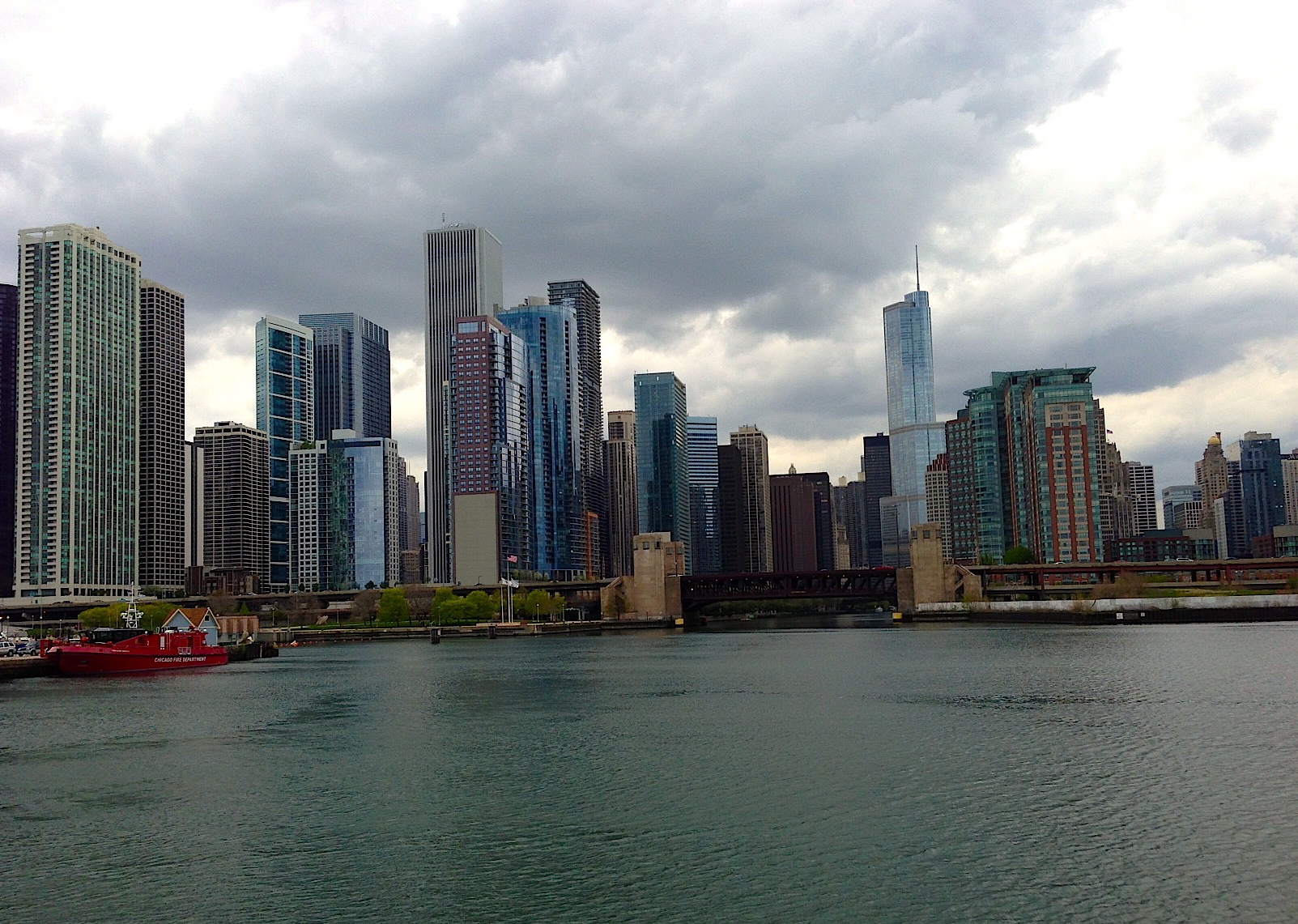
Photo by John Mariani (2013)
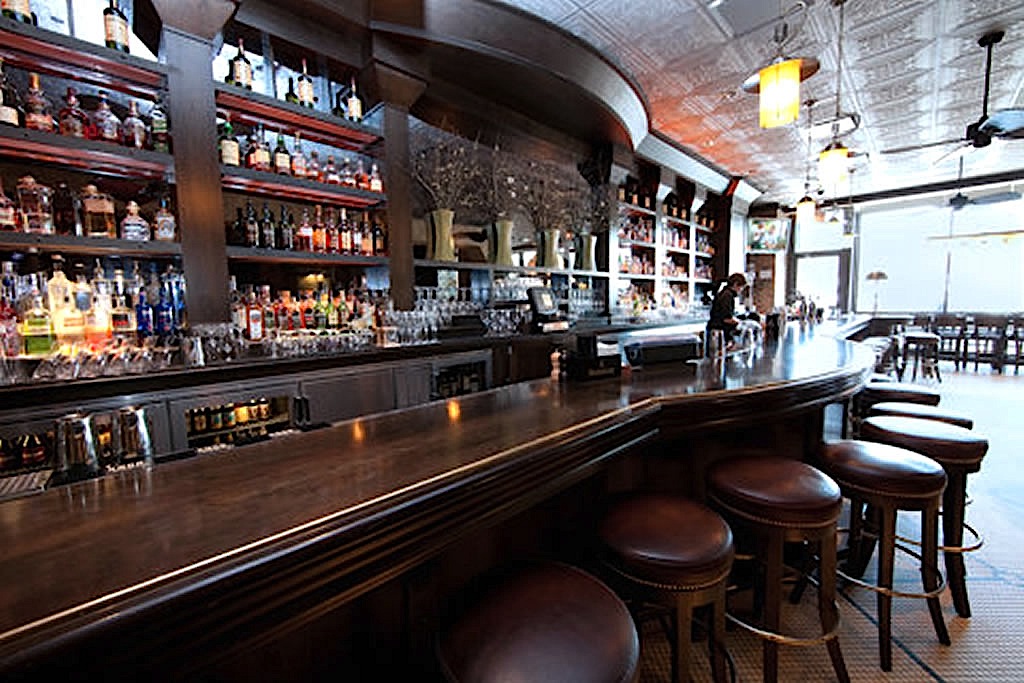 The
Gage
The
Gage
24 South Michigan Avenue
312-372-4243
thegagechicago.com
In
a city of such wide-ranging ethnic culinary
talent, there’s no such thing as a “typical”
Chicago restaurant, despite its rep as a
steakhouse town. But, if you could gather up all
the gregarious good will and the level of
satisfaction palpable at The Gage, you’d have a
good idea.
Opened in 2007, The Gage looks and feels like
it’s been here 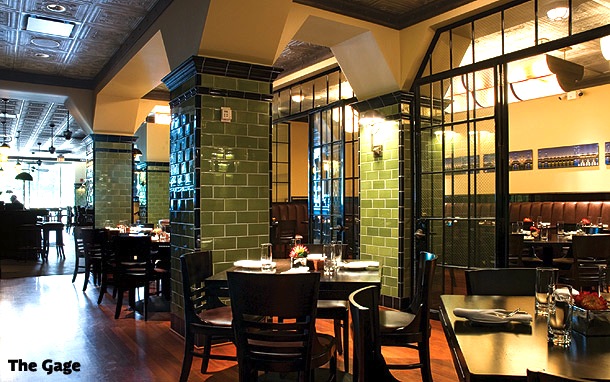 since
the Roaring Twenties, lodged in a group of three
buildings built in 1889 and 1890, with a
façade by Chicago master architect Louis
Sullivan. The current owners, the Lawless
family, who hail from Galway, lent the place a
certain Irish swagger and big-hearted hospitality,
practiced over the years at their other
Chicago restaurants and hotels like Gallows
Prospect Hill, The Irish Oak, Taaffe’s Shop
Street, Tigh Coilin and The Twelve Pins.
since
the Roaring Twenties, lodged in a group of three
buildings built in 1889 and 1890, with a
façade by Chicago master architect Louis
Sullivan. The current owners, the Lawless
family, who hail from Galway, lent the place a
certain Irish swagger and big-hearted hospitality,
practiced over the years at their other
Chicago restaurants and hotels like Gallows
Prospect Hill, The Irish Oak, Taaffe’s Shop
Street, Tigh Coilin and The Twelve Pins.
The
Gage is a smart looking bi-level room, with
green-tiled pillars, plenty of dark wood, white
tablecloths, art deco touches, and, as you’d
expect, a great bar and bar scene. It’s as
all-out-American as it comes; no one leaves hungry
or complains about the moderate prices for this
kind of largess. In among the steaks and
chops—and a $17 venison burger with onion, Gouda,
fried jalapeño, mushrooms and more—there
are unusual items like bison tartare with pear and
mustard emulsion; a platter of fabulous sweet sea
scallops seared and 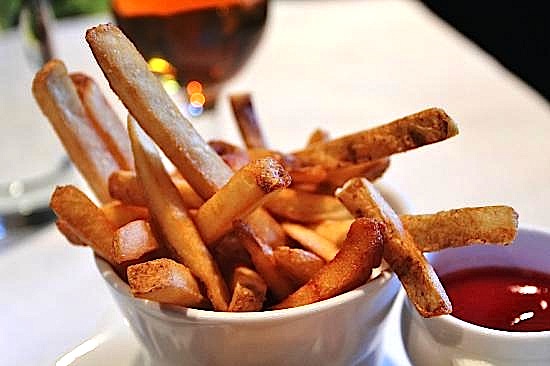 served with
Chinese broccoli; Korean BBQ short ribs, toasted
peanuts and kimchi--as hearty as things get
here--and poutine, which, if not rigorously
Canadian in style, is packed with smoked pork
confit, pickled red onions, cheese curds and
chips.
served with
Chinese broccoli; Korean BBQ short ribs, toasted
peanuts and kimchi--as hearty as things get
here--and poutine, which, if not rigorously
Canadian in style, is packed with smoked pork
confit, pickled red onions, cheese curds and
chips.
At
lunch, too, the menu goes beyond the ordinary,
with items like a hot pastrami sandwich on marble
rye with Guinness-soaked Swiss, red cabbage slaw
and rémoulade, and a New England lobster
roll with fried onions and potato chips.
For dessert, by all means have
the strawberry shortcake, but deflect the basil
ice cream from it as a topping.
Dinner entrees $11-$42.
Sepia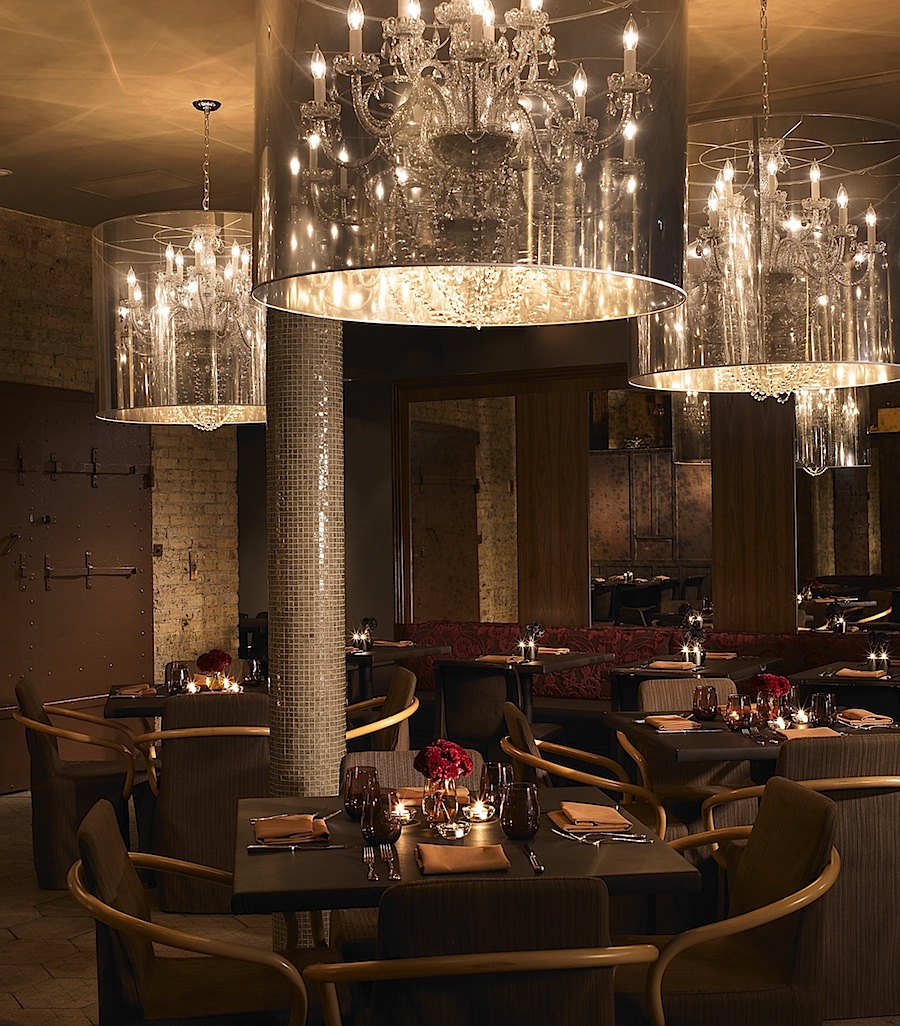
123
North Jefferson Street
312-441-1920
www.sepiachicago.com
Opened
in 2008, Sepia has only gotten better under Chef
Andrew Zimmerman (below), whose way with
Mediterranean flavors gives him wide range to show
his innovative cast. At this point, I’d
certainly rank him among the top ten chefs in
Chicago for the way he makes every ingredient
count, sparkle and express his own personal taste.
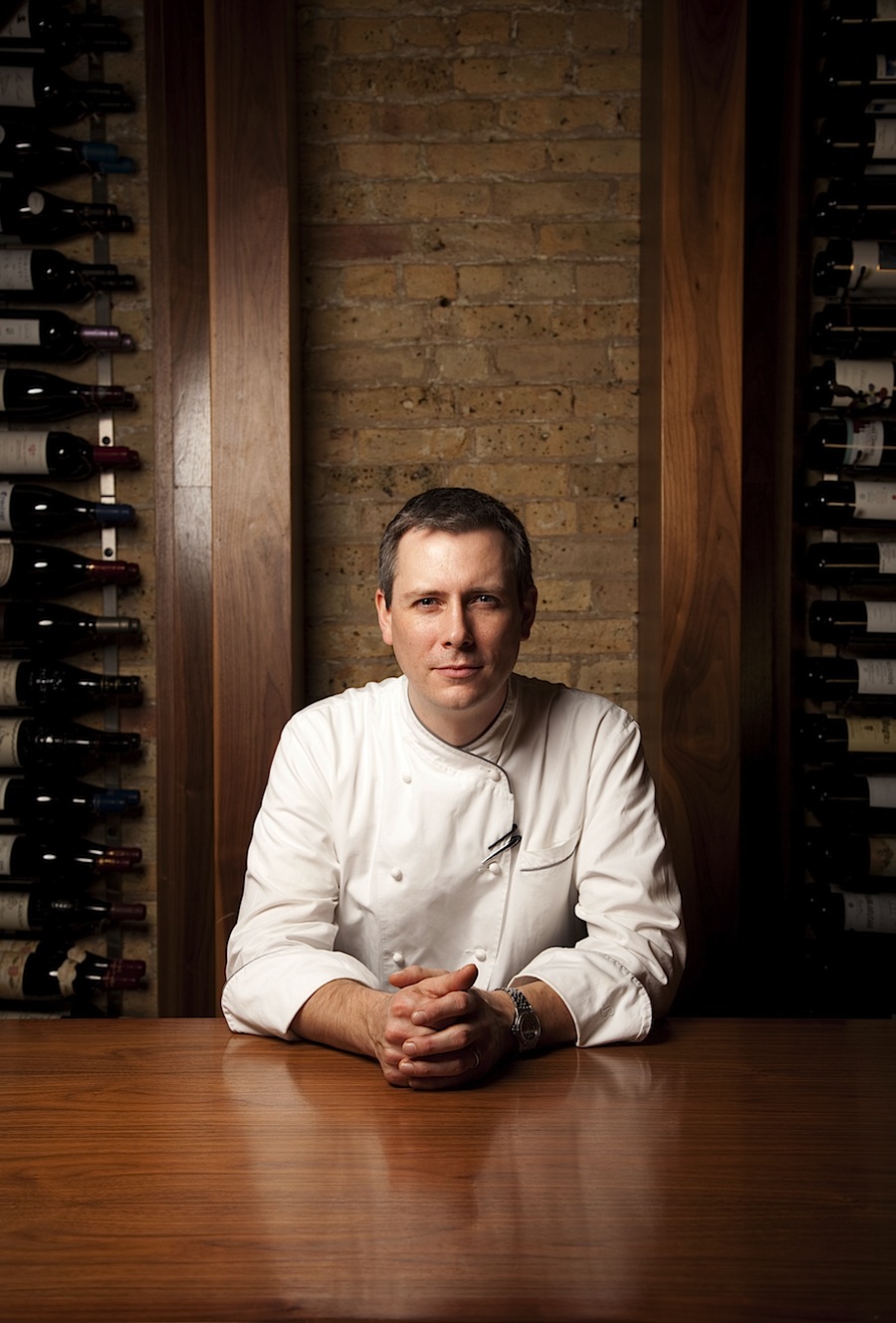 Suavely
dressed owner Emmanuel Nony has fashioned the
rooms with an abundance of deep, rich colors, with
oak wood, brickwork and antique mirrors, mementos
from the building's history as a 19th century
print shop, with art nouveau touches throughout.
The floor-to-ceiling wine display holds more than
800 bottles, many under $75.
Suavely
dressed owner Emmanuel Nony has fashioned the
rooms with an abundance of deep, rich colors, with
oak wood, brickwork and antique mirrors, mementos
from the building's history as a 19th century
print shop, with art nouveau touches throughout.
The floor-to-ceiling wine display holds more than
800 bottles, many under $75.
I left myself in Zimmerman’s
hands and was richly rewarded with dishes that
showed his remarkable finesse. Foie gras took on a
sour cherry gelée, the crunch of hazelnuts
and buttery brioche toast. A soft-cooked egg
was rendered crispy, oozing over the season’s best
morels, asparagus and ramps, while a potato and
ramp soup took on a lovely smokiness from morsels
of trout. Adding brandade-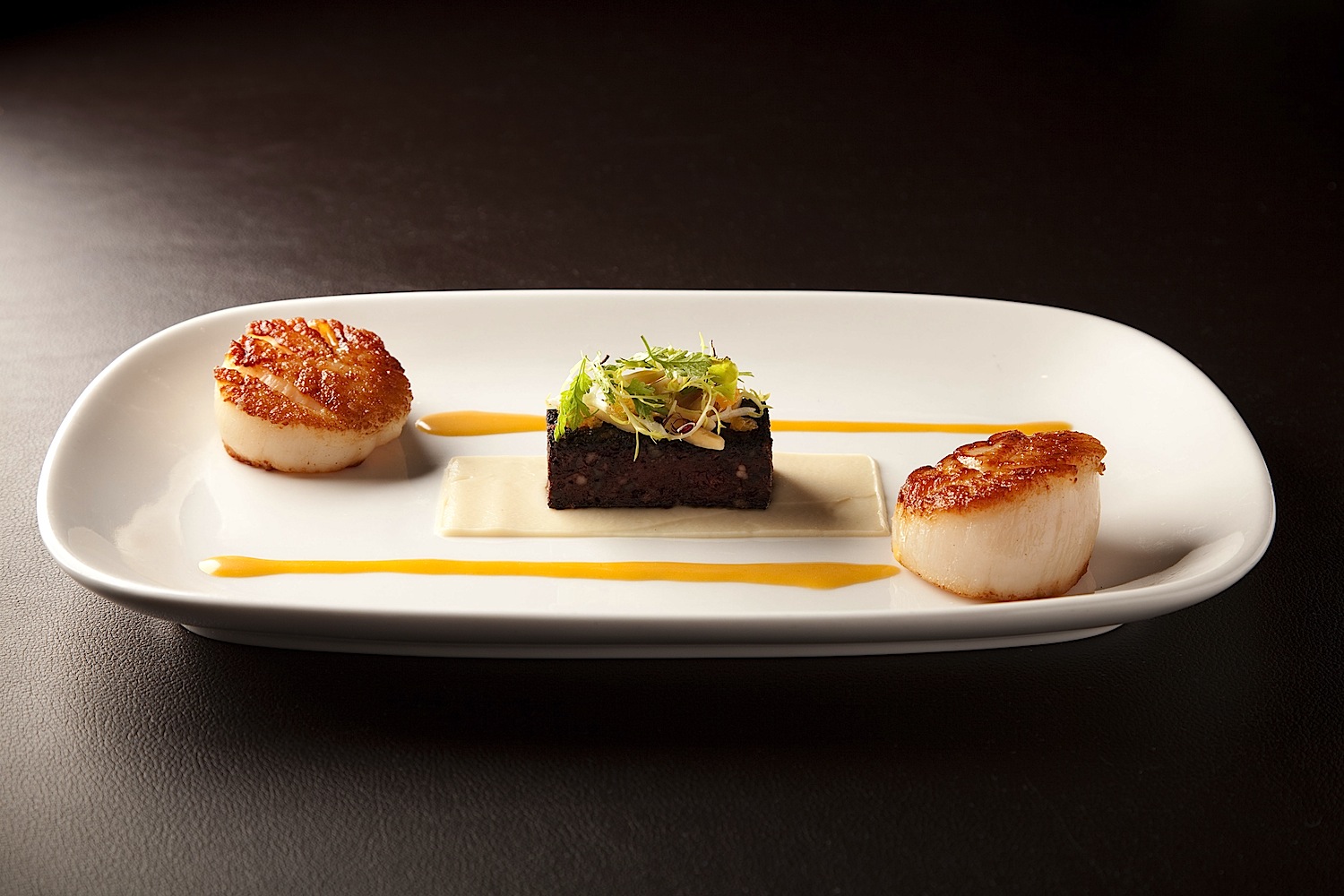 stuffed tortellini and
mint pesto to delicately flavorful halibut was a
fine idea, as was making a pastrami of wagyu-style
beef alongside a cut of bavette with a
classic bordelaise and onion jam. Tea-soaked
prunes and sweet hoisin were an honorable marriage
with Berkshire pork, and it was good to see
chicken thigh treated to red wine braising, like
old-fashioned coq au vin, here served with
leeks, truffle jus and pistachios.
stuffed tortellini and
mint pesto to delicately flavorful halibut was a
fine idea, as was making a pastrami of wagyu-style
beef alongside a cut of bavette with a
classic bordelaise and onion jam. Tea-soaked
prunes and sweet hoisin were an honorable marriage
with Berkshire pork, and it was good to see
chicken thigh treated to red wine braising, like
old-fashioned coq au vin, here served with
leeks, truffle jus and pistachios.
How do
you distinguish chocolate mousse these days? Make
it from malted chocolate milk, add peanut butter
crunch and pretzel bark with a touch of salt.
Chocolate date cake was lavished with mascarpone
and orange syrup. Damn good ideas.
The thinking behind all these
shows an inventive mind grounded in rigorous
technique. While a handful of Chicago chefs
are trying to create bedazzlements based on little
but artifice, Zimmerman is showing the way things
can and should be done.
Dinner entrees
$28-$36.
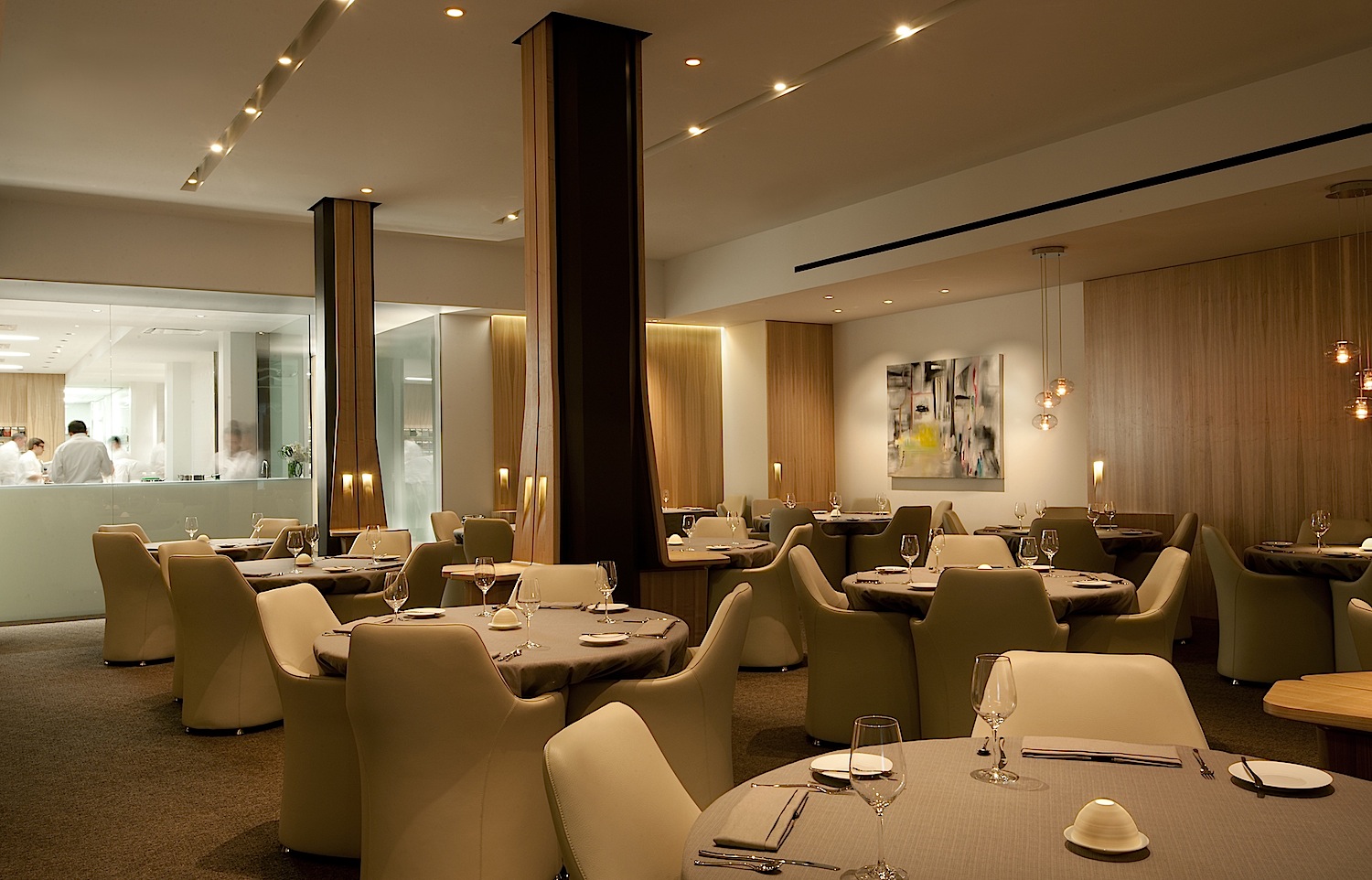 Grace
Grace
652 West Randolph Street
312-234-9494
grace-restaurant.com
While
I’m on the subject of dazzle, a consideration of
what Grace is doing leaps to mind. Curiously
enough, I had read an interview in which
chef-owner Curtis Duffy said he would not be
mimicking the molecular/modernist cuisine of
others in town, like Grant Achatz (for whom he
once worked) and Homaro Cantu, so I was
dumbfounded to find that Duffy’s menu is riddled
with such hocus-pocus, which seem all out of
whack with the beautifully serene dining room at
Grace, with its muted colors, soft surfaces and
lighting, and the glow of a glassed-in kitchen.
It’s a supremely comfortable space, which, despite
local media insisting it’s a tough table to get,
was half empty when I dined there this spring.
The
kitchen is a vast space with six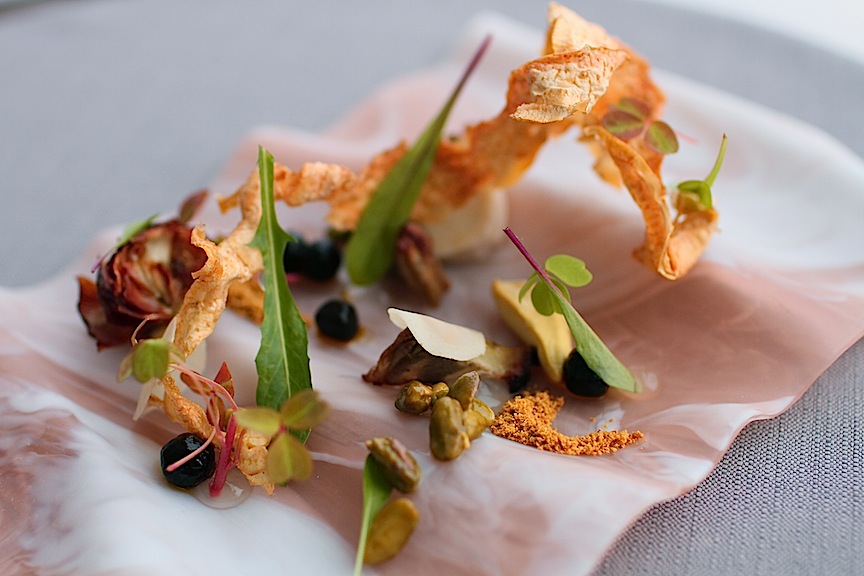 counters, 14
refrigerators and 17 chefs, who work in monastic
silence, primping and decorating dishes for
minutes at a time after they come from the heat,
when they are heated at all.
counters, 14
refrigerators and 17 chefs, who work in monastic
silence, primping and decorating dishes for
minutes at a time after they come from the heat,
when they are heated at all.
I won’t go through the screed
of the dozen dishes (12 each on the “Flora” and
“Fauna” menus, at $185 plus wines), but when the
first thing placed on our table was a literal
Br’er Rabbit thicket of twigs hiding mostly sweet
morsels of lemon jelly; a gougère
with pureed fava beans and sweetened lemon; a
single dehydrated tapioca chip with lardo
and scallion puree; a Medjool date with
ultra-sweet hibiscus syrup; and a green strawberry
with red strawberry tart--just the things that do
not set up the appetite--I knew I 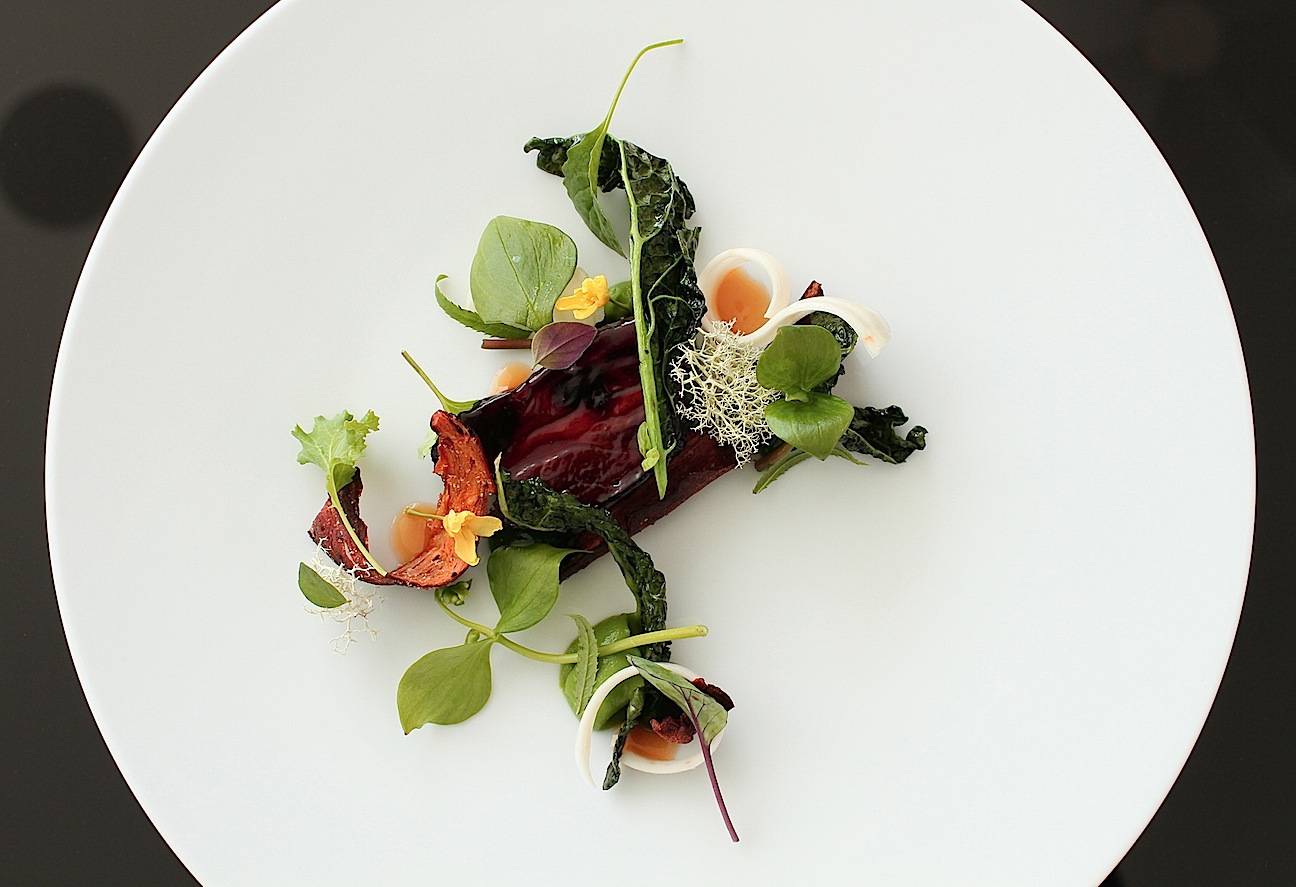 was in for a ride.
Or being taken for one.
was in for a ride.
Or being taken for one.
The dishes then mounted in
pretension: maitake
mushroom and daikon radish with coffee; a frozen
beet puree with black garlic; frozen Chartreuse
ice cream with oranges and more lemon; smoked
banana pudding with pistachio powder, sweet curry
and dandelions; and tapioca foam on king crab. Not
all these were desserts.
Six
courses in, my friend and I were literally craving
food—“Wanna go for pizza after we get out of
here?” he asked--satisfied only by the little
slice of richly marbled Miyazaki beef with
mushrooms, salsify and something called mashua
leaf, on the Fauna side of the menu. We
fought over it.
It’s
easy to call such food silly, but there is
something more disturbing about the idée
fixe that a chef will strut his stuff and the
guest will have no say and, perhaps, leave hungry
after a meal that will cost upwards of $350 with
wine. Grace is firmly part of the
Chicago Radical School, whose members have
received extravagant praise for how much they can
possibly manipulate ingredients—powders, gels,
liquid nitrogen, ice creams made from savories,
and so on, all presented in teeny portions.
Why does Br'er Rabbit come to mind again?
Embeya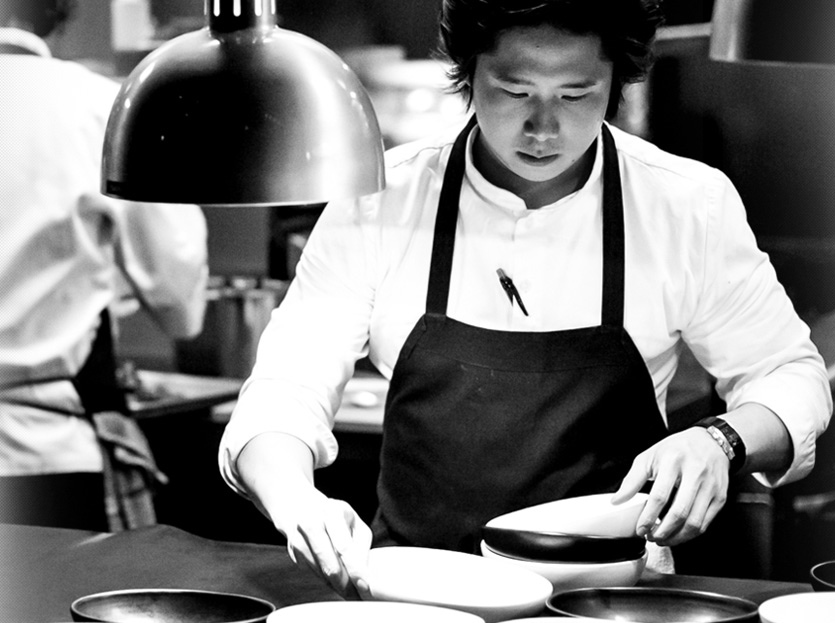
564 West Randolph Street
312-612-5640
embeya.com
Embeya
is Vietnamese for “little one,” an affectionate
childhood nickname for chef Thai Dang (right), who
did not strike me as particularly small in stature
but did impress me with his enormous talent for
showcasing Vietnamese and other Asian cuisines at
this glamorous new restaurant in the West Loop.
 High ceilings, tall windows, a
gleaming bar, carved teakwood panels and airy
ice-like chandeliers give this dining room the
cast of one that might well vie with the most
sophisticated in Saigon, whatever that may be. Add
to the mix the handsome couple of owners
Komal Patel and her bearded husband Attilla Gyulai
and you have good reason to drop by for a cocktail
and stay for a meal as the place fills up with a
well-dressed crowd out to impress their own ilk.
High ceilings, tall windows, a
gleaming bar, carved teakwood panels and airy
ice-like chandeliers give this dining room the
cast of one that might well vie with the most
sophisticated in Saigon, whatever that may be. Add
to the mix the handsome couple of owners
Komal Patel and her bearded husband Attilla Gyulai
and you have good reason to drop by for a cocktail
and stay for a meal as the place fills up with a
well-dressed crowd out to impress their own ilk.
Gyulai honed his attention to
detail at The Four Seasons and learned about Asian
fusion cuisine at CityZen in DC. Tenure at
L20 in Chicago gave him an insight into the most
modern ideas of seafood cuisine. All of this,
along with Patel’s effortless hospitality and
Dang’s superb cooking, makes Embeya a striking
example of its kind in Chicago, and one worth
other chef’s regard in other cities.
The Vietnamese dishes are the
most delicate, influenced by French cuisine, as in
the shrimp wrap with shiitake, lettuce and herbs
and 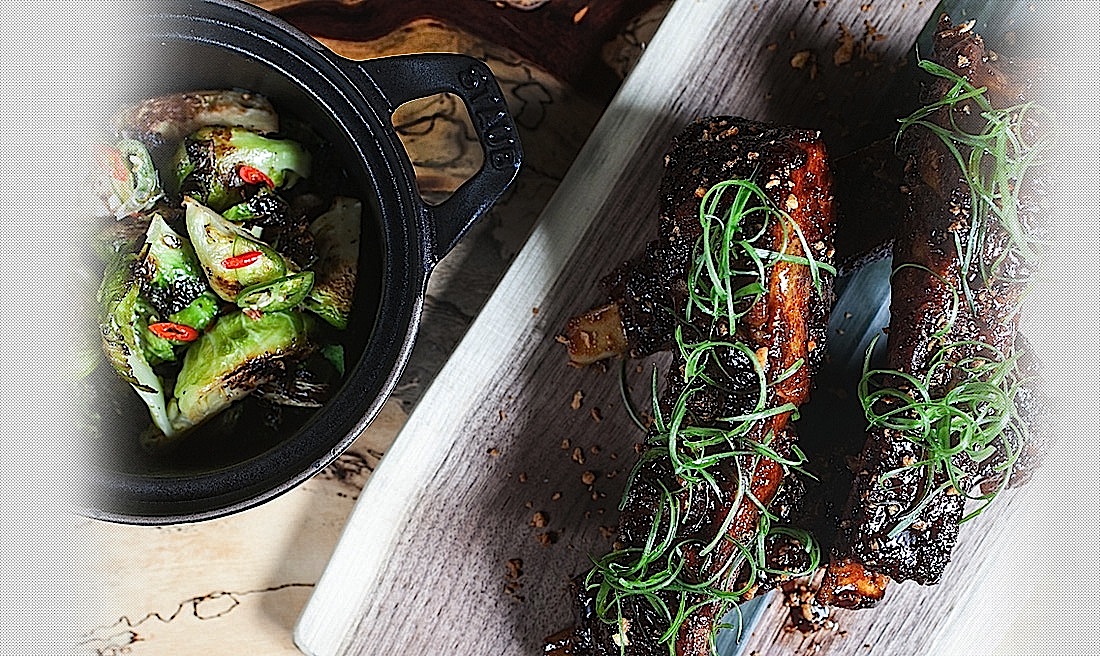 the rice noodle salad
with short rib and lemongrass. Chinese
flavors are evident in the tamarind-coated ribs
with toasted garlic and hoisin sauce, while a
rabbit leg gets a Thai treatment of chili,
marinated peas and radish. Desserts are every bit
as tantalizing, like the fried banana with coconut
ice cream, caramel, and the addictive mango
and sticky rice pudding.
the rice noodle salad
with short rib and lemongrass. Chinese
flavors are evident in the tamarind-coated ribs
with toasted garlic and hoisin sauce, while a
rabbit leg gets a Thai treatment of chili,
marinated peas and radish. Desserts are every bit
as tantalizing, like the fried banana with coconut
ice cream, caramel, and the addictive mango
and sticky rice pudding.
There’s a 3-course lunch at a mere $21, and
prices at dinner are moderate, with main courses
$14-$21.
PART TWO of this article
will appear shortly.
❖❖❖
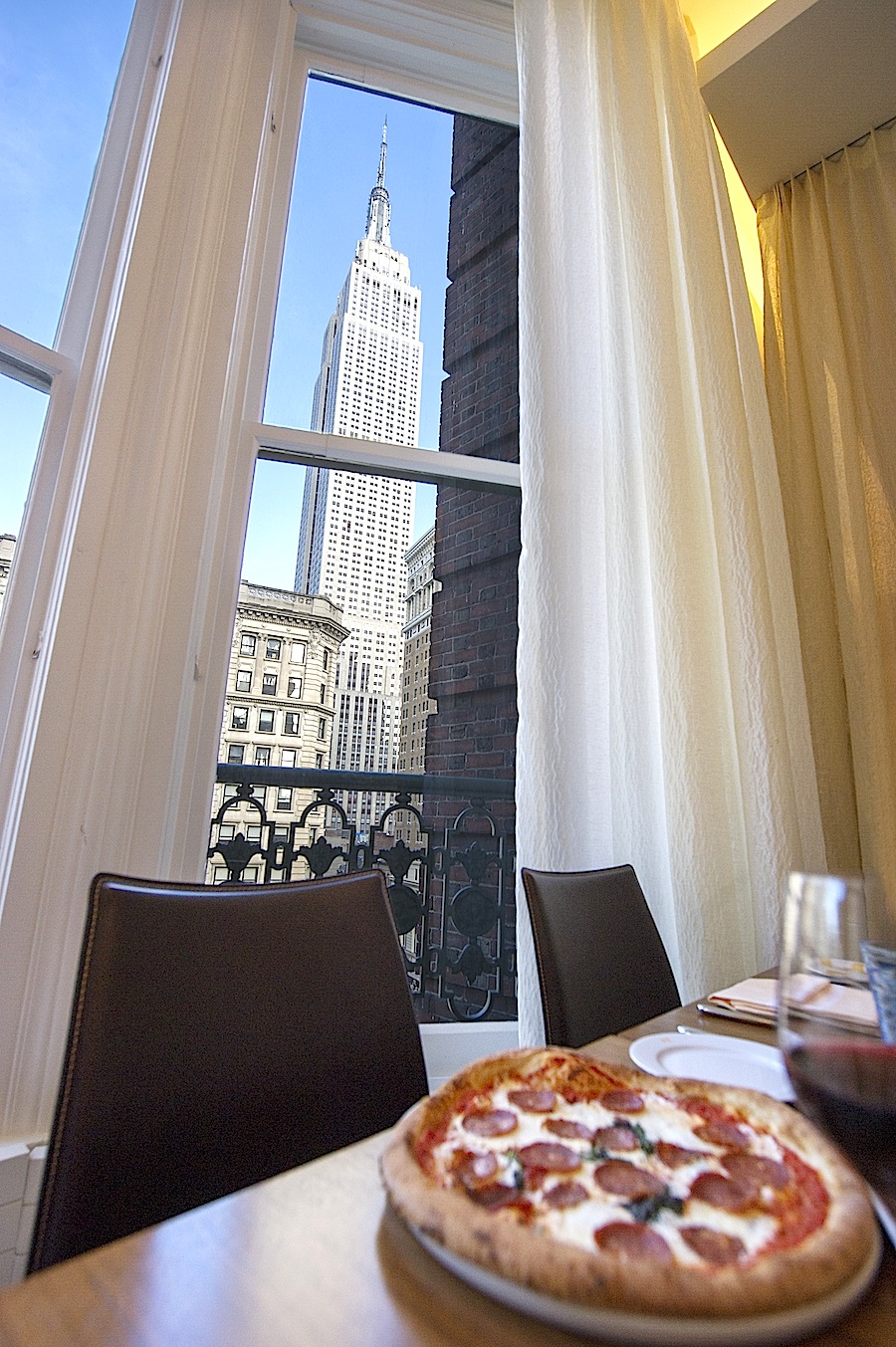 STELLA
34 Trattoria
STELLA
34 Trattoria
Broadway and
35th Street
212-967-9251
stella34
So far several NYC critics have heaped praise on Stella 34 Trattoria: Gael Greene wrote,
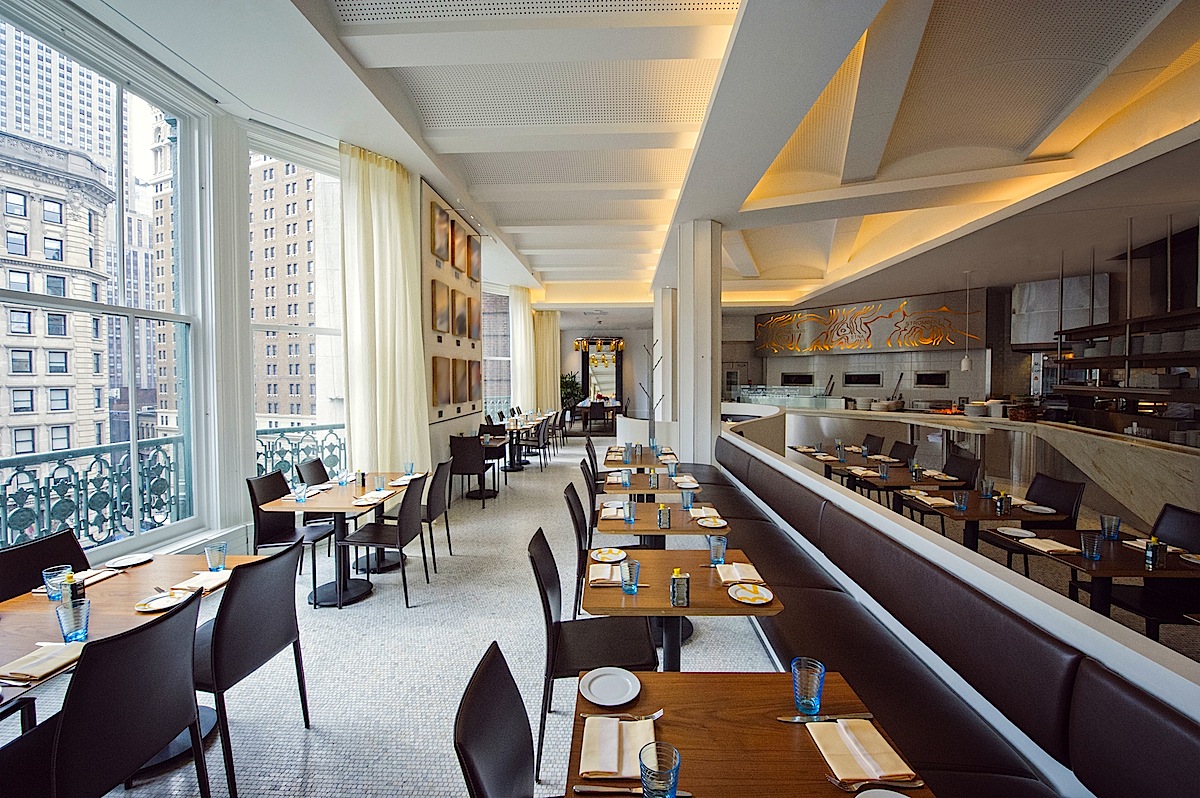 “The truth is, I love most everything
I’ve eaten here” and the NY Post called it
“The Food Miracle on 34th Street.” Still, all
churlishly note that the sixth floor is the bedding
and mattress floor, which can be seen when the
restaurant’s curtains are parted. There is also a
wink-wink that, well, this is Macy’s, not
Bergdorf Goodman. Bergdorf should be so lucky.
So should Bloomingdale’s, Lord & Taylor, Saks
Fifth Avenue and every other department store in the
city, most of which begrudgingly put in a celebrity
chef’s eatery as a convenience. (One exception, Armani
Fifth Avenue, though the frequent chef changes there
make it frustratingly uneven.)
“The truth is, I love most everything
I’ve eaten here” and the NY Post called it
“The Food Miracle on 34th Street.” Still, all
churlishly note that the sixth floor is the bedding
and mattress floor, which can be seen when the
restaurant’s curtains are parted. There is also a
wink-wink that, well, this is Macy’s, not
Bergdorf Goodman. Bergdorf should be so lucky.
So should Bloomingdale’s, Lord & Taylor, Saks
Fifth Avenue and every other department store in the
city, most of which begrudgingly put in a celebrity
chef’s eatery as a convenience. (One exception, Armani
Fifth Avenue, though the frequent chef changes there
make it frustratingly uneven.) Stella 34 Trattoria is a
partnership between Macy’s and the Patina Group,
which also runs Lincoln Ristorante, Sea Grill,
Fonda del Sol, Naples 45 and several other
restaurants in NYC, as well as the Patina
restaurant in the Frank Gehrey-designed Disney
Music Hall in LA and the Renzo Piano-designed
Ray’s at the Los Angeles Museum of Contemporary
Art, so they have a pretty good grip on what makes
a modern restaurant of style and substance.
Stella 34 Trttoria is a
stunner, an arched dining room with a take-out
section called Cibi Ronda up front and a gelateria
serving what is considered the best ice cream in
Florence, Vivoli. There are also three
wood-burning ovens that produce creditable pizzas.
The walls are hung with caricatures by
Robert Risko. There is fine marble everywhere, and
you look out at the Empire State Building (above), whose
spire changes color every night.
Chef Jonathan Benno of Lincoln
is consulting chef here; Jarett Appell, trained by
Italian master Gualtiero Marchesi, is executive
chef. They have crafted a menu of both traditional
and updated Italian regional cuisine that begins
with luscious farrotto grain teeming with
fresh fava beans, peas, asparagus, and pecorino.
You can put together a
winning selection of antipasti as a lunch
or early dinner from items like potatoes scented
with rosemary and pecorino; wood-roasted
mushrooms; excellent caponata with smoked
ricotta salata; baby octopus with escarole,
potatoes and a romesco sauce; and polpettine
veal meatballs made with sheep’s milk ricotta.
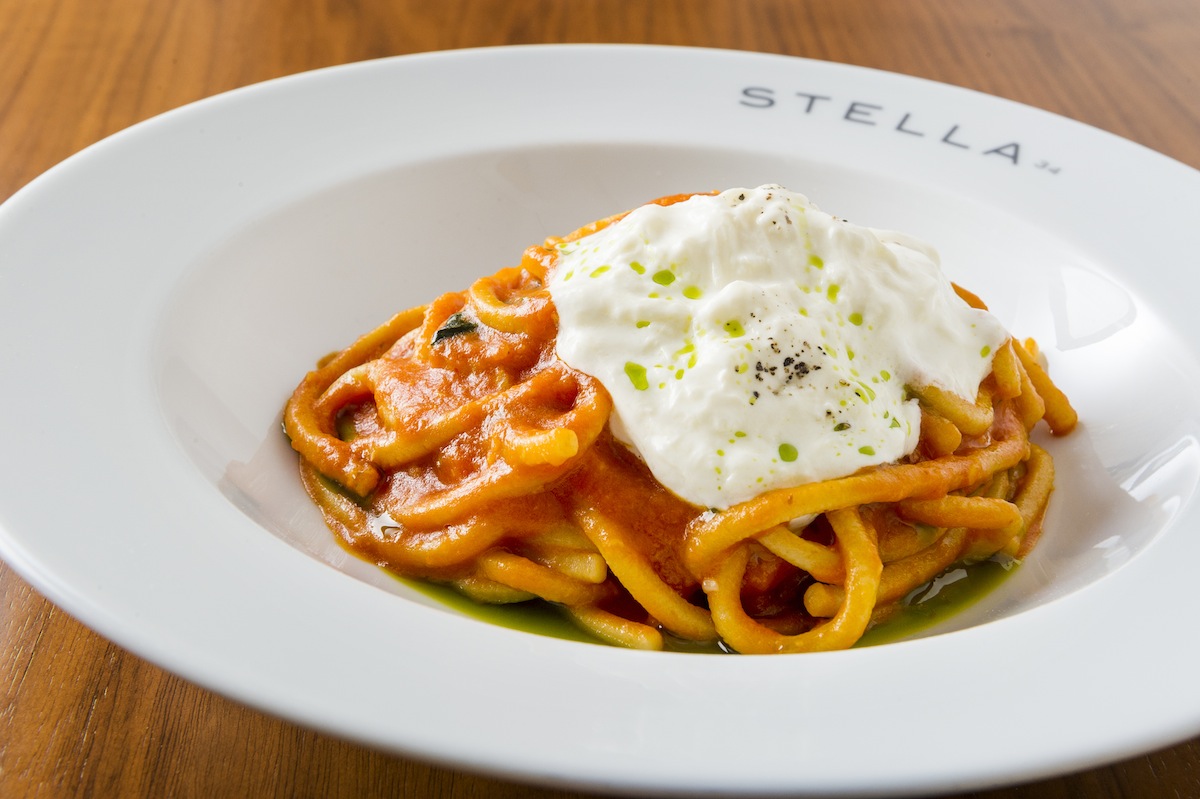 The pizzas are classic
styles, with none of the extravagant toppings so
faddish elsewhere. So you have a choice of a
margherita;
a diavola with spicy salami; quattro
stazioni with tomato, ham, eggplant,
artichokes, mushrooms and fontina, and others each
night.
The pizzas are classic
styles, with none of the extravagant toppings so
faddish elsewhere. So you have a choice of a
margherita;
a diavola with spicy salami; quattro
stazioni with tomato, ham, eggplant,
artichokes, mushrooms and fontina, and others each
night.
Every pasta I tasted was
superb, not least the tube paccheri with
braised beef ragù and the plump strozzopreti
with cuttlefish (one of Benno’s masterpieces). An
Abruzzese spaghetti alla chitarra with
simple tomato sauce is a triumph of good taste (left).
From those wood-burning ovens
comes a Berkshire pork chop with a lovely
dandelion salad, cherry compote for tang, a smoky
bacon-sherry vinaigrette and lush Gorgonzola dolce.
Other main courses are not so complex, like
the wonderful pancetta-wrapped halibut
with mint and a golden raisin agrodolce.
The scampi here are indeed
scampi, not just big shrimp, and they are
sweet and delicious, with a green garlic puree and
cooked wine.
By all means order dessert,
perhaps a selection of any of the 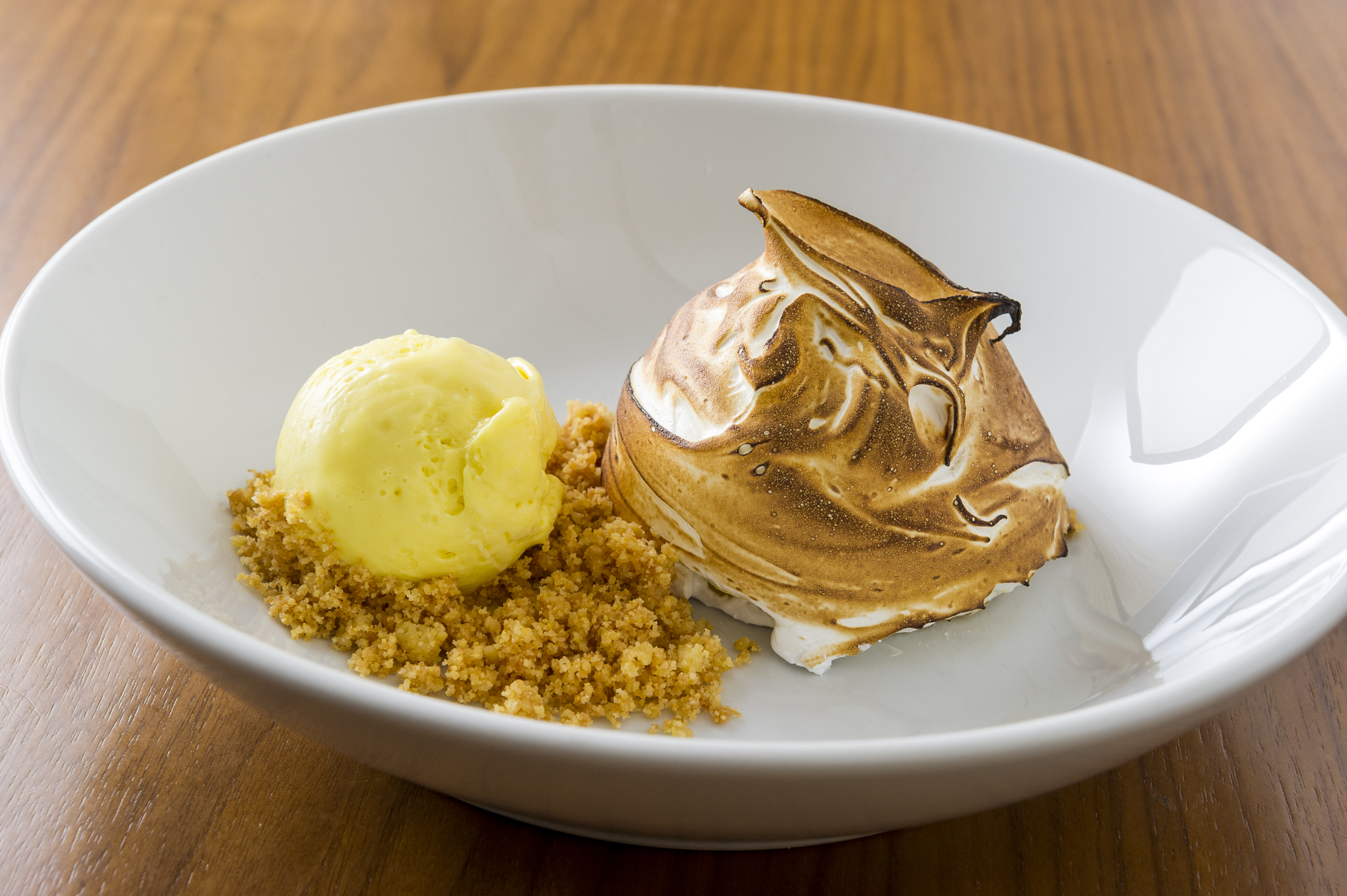 baker’s dozen of those
fabulous Vivoli gelati, or the “bongo”
cream puffs with macerated cherries, whipped cream
and chocolate sauce.
baker’s dozen of those
fabulous Vivoli gelati, or the “bongo”
cream puffs with macerated cherries, whipped cream
and chocolate sauce.
Swooning is in order at Stella
34, and you will be in the hands of a highly
cordial staff that, under general manager Matt
Gardiner, doles out equal parts friendliness and
professional courtesy to everyone.
Macy’s and Patina should
be very proud of what they’ve produced at Stella
34 Trattoria. It becomes very much a dynamic
addition to the Herald Square area, with its
pedestrian mall, Macy’s decorated windows, and a
sense of NYC’s unique blend of nostalgia and
modernism.
Stella 34
is open for lunch Mon.-Sat.; for dinner nightly;
offers a $25 lunch and $38 dinner, with dinner
à la carte at $6-$10 for antipasti, $17-$22
for full pastas, and $17-$32 for main courses.
❖❖❖
NOTES FROM THE WINE CELLAR
by John Mariani
 More
than 150 years before California had vineyards,
settlers in Jamestown, Virginia, were crushing
grapes.
More
than 150 years before California had vineyards,
settlers in Jamestown, Virginia, were crushing
grapes.
And by the time Father Junipero
Serra brought the Mission grape to San Diego, Thomas
Jefferson was planting Monticello with European
vinifera.
For the next century Virginia
wineries struggled and then were killed off by
Prohibition. It was not until the 1970s, when new
wineries planted chardonnay, merlot, and cabernet
franc, that people took notice of the state’s
viticulture. Since then, Virginia’s wineries have
grown from six in 1979 to 230 today. It boasts 15
distinct wine regions, seven approved as American
Viticultural Areas, annual production of 475,000
cases and 2010 retail sales of $73 million,
according to the most recent data available.
Wine tourism has become big
business, too, with 1.6 million visitors spending
$131 million annually. The state has 26 wine trails,
many on or near Civil War battlefields. Driven
largely by investors from other industries and other
states, millions of dollars have been poured into
land far less expensive than Napa 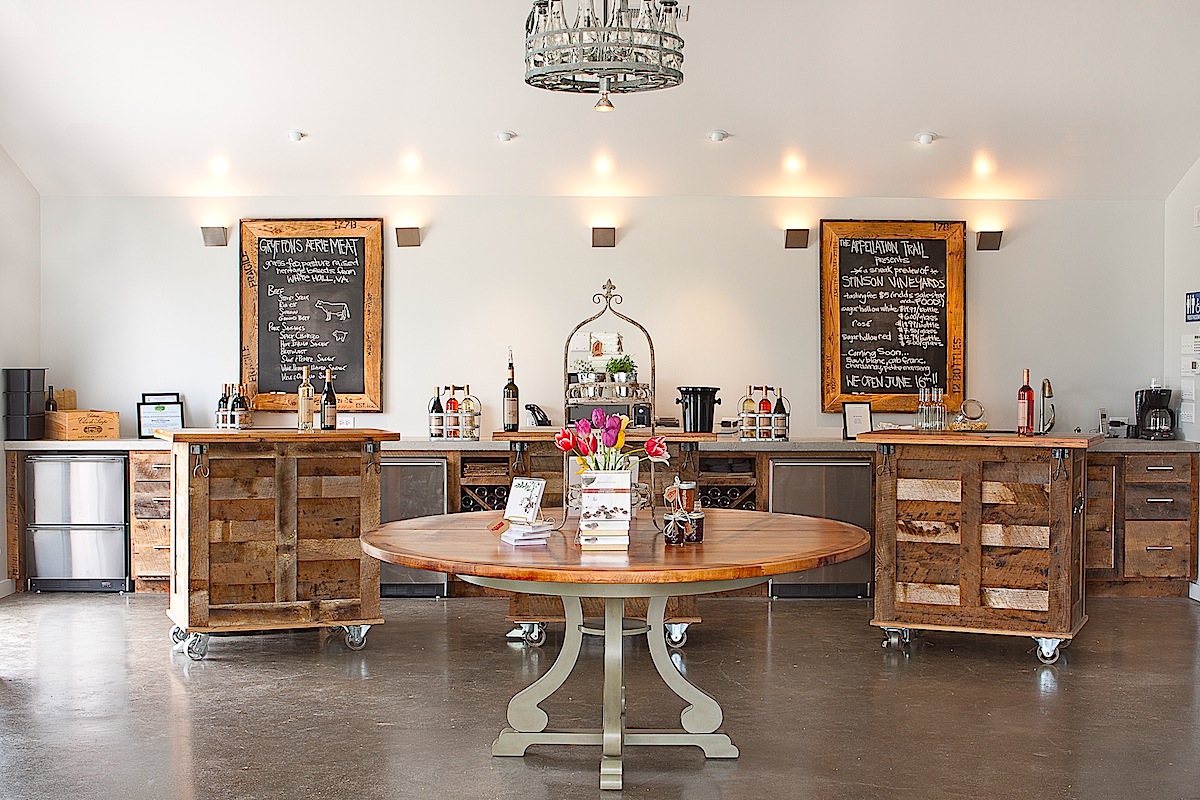 or Sonoma Valley.
or Sonoma Valley.
Not all have succeeded. In 1999
Patricia Kluge and her husband, Bill Moses, invested
$10 million to build a 100-acre Charlottesville
winery. A messy divorce was followed by bankruptcy,
allowing Donald Trump to scoop up the entire
1,300-acre Kluge estate last year, re-naming it
Trump Winery.
Over the past decade I’ve been
impressed with the progress of Virginia’s wines,
especially its Bordeaux-style reds. A tasting of
several showed me that they have gone from
promising, one-dimensional wines to well-made, more
complex varietals with standout fruit flavors.
The most impressive was
a Stinson
Vineyards Meritage 2011 ($35), made in the
Blue Ridge Mountains, a Bordeaux blend at just 13.4
percent alcohol, aged 14 months. It had everything I
look for in a red wine: a balance of
pronounced fruit, softened tannins, and enough acid
to give it spark. That's their tasting room at the
right.
Pollak
Vineyards of Monticello, founded in 2003
by Margaret and David Pollak, wine pioneers in
California’s Carneros region, produces a range of
white and red wines. I tasted their cabernet franc
2009 Reserve ($40), aged in French oak for ten
months. It had an amazing amount of bright cassis
flavors and soft tannins characteristic of a
varietal that is wonderful to drink with chicken or
pork. The 2011 vintage is $22.
So, too, I was delighted with the
velvety texture of Lovingston
Winery's 2009 Estate Reserve Josie’s Knoll ($25),
with 85 percent merlot, 10 percent cabernet franc
and 5 percent petit verdot to buoy the body of the
wine. There is complexity from start to finish, and
this is very well priced.
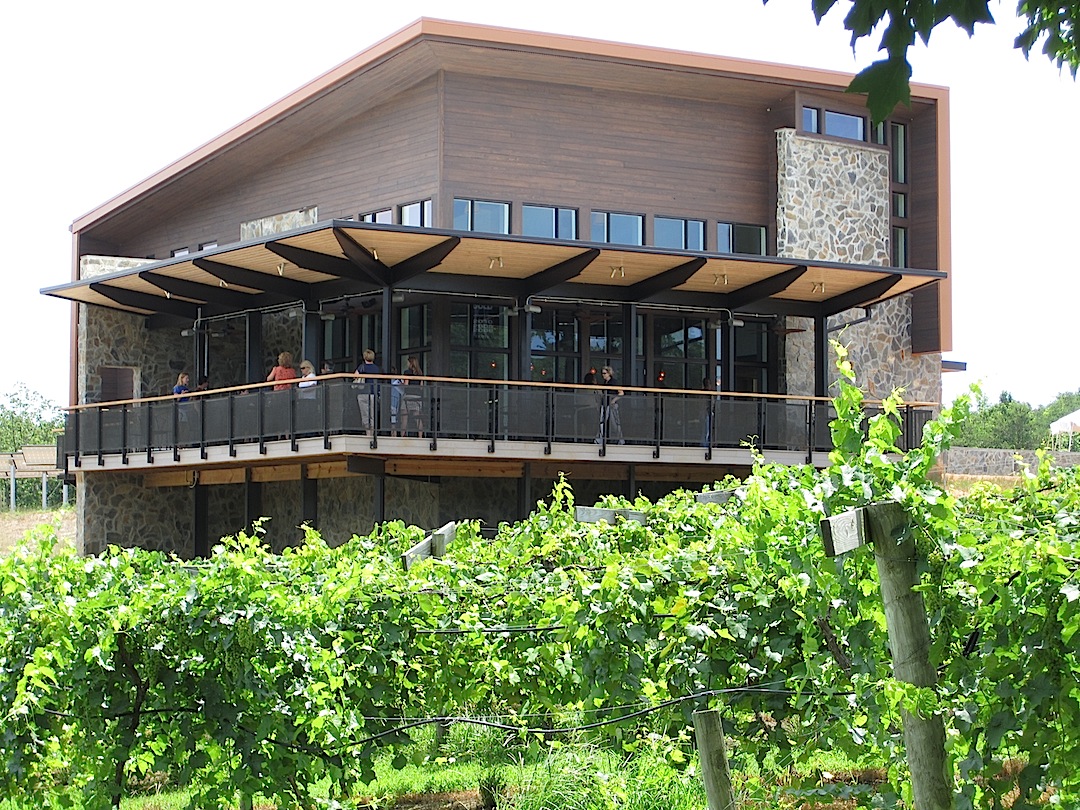 King Family Vineyards
Meritage 2010 ($28) shows a sweeter
profile, the merlot up front, the alcohol hitting
14.5 percent, which blunted finesse. RdV Vineyards Lost
Mountain 2010 Bordeaux blend was even
hotter, dense and unappealing. And at $88 upon
release this fall, it is aiming for those who like
huge red wines with high alcohol, at 14.7 percent.
The winery’s Rendezvous 2010 ($75), even higher at
14.9 percent, was grapey, without an acid component
to tame it.
King Family Vineyards
Meritage 2010 ($28) shows a sweeter
profile, the merlot up front, the alcohol hitting
14.5 percent, which blunted finesse. RdV Vineyards Lost
Mountain 2010 Bordeaux blend was even
hotter, dense and unappealing. And at $88 upon
release this fall, it is aiming for those who like
huge red wines with high alcohol, at 14.7 percent.
The winery’s Rendezvous 2010 ($75), even higher at
14.9 percent, was grapey, without an acid component
to tame it.
I was much happier with a $50
bottle of Sunset
Hills Vineyard Mosaic Red Wine 2010, with
14 percent alcohol. The winery aims to make big reds
that will age 15 years, but I found the 2010 quite
appealing. Sourced from three vineyards in Loudon
County, the Bordeaux blend, with only 186 cases
made, may hint at what Virginia terroir can do for a
Bordeaux blend of varietals, with a sunnier profile.
Philip Carter Winery takes pride in its
tenure of the land for three centuries. The 2010
Cleve is a 50:50 blend of petit verdot and tannat,
aged in French and American oak, and “designed for
longevity,” a decision that makes this very
cherry-fruited, big-bodied red highly tannic at this
point. It will be at least two years before this
really shows any maturity.
Petit verdot all on its own is
behind Cooper
Vineyards (above) Reserve 2010 ($30), with 13.8
percent alcohol. The grape shows its warm fruitiness
without being cloying, and the wine is very smooth
from start to finish, which makes it a good match
for lamb and Mediterranean dishes like couscous and
tagines.
Jefferson, who considered wine
“the only antidote to the bane of whiskey,” must be
smiling under the soil of Monticello.
This article first
appeared in Bloomberg
News.
❖❖❖
NOW,
NOW. . . 
"A variation
on Mr. Boulud’s classic roasted sea bass with
syrah sauce came with radicchio so bitter I
wanted to slap it."--Pete Wells, "Daniel," NY
Times.
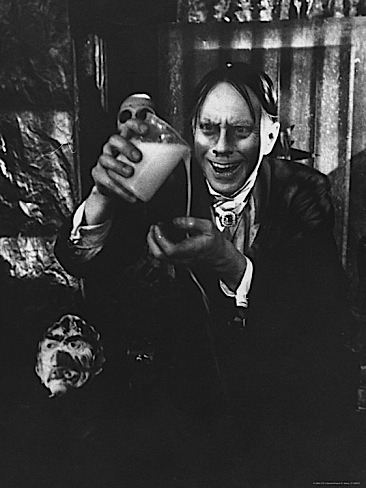 TASTES
JUST LIKE CHICKEN!
TASTES
JUST LIKE CHICKEN!
By
using stem cells from cows, scientists from
the Netherlands
created the
first laboratory-made hamburger.
See video:
www.heavy.com/news/2013/08/lab-grown-burger-eaten-video/
❖❖❖
Any of John Mariani's
books below may be ordered from amazon.com.
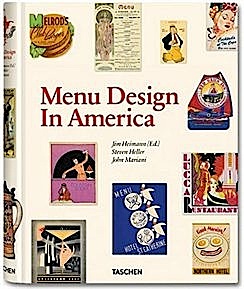 |
My latest book, which just won the prize for best book from International Gourmand, written with Jim Heimann and Steven Heller, Menu Design in America, 1850-1985 (Taschen Books), has just appeared, with nearly 1,000 beautiful, historic, hilarious, sometimes shocking menus dating back to before the Civil War and going through the Gilded Age, the Jazz Age, the Depression, the nightclub era of the 1930s and 1940s, the Space Age era, and the age when menus were a form of advertising in innovative explosions of color and modern design. The book is a chronicle of changing tastes and mores and says as much about America as about its food and drink.
“Luxuriating vicariously in the pleasures of this book. . . you can’t help but become hungry. . .for the food of course, but also for something more: the bygone days of our country’s splendidly rich and complex past. Epicureans of both good food and artful design will do well to make it their coffee table’s main course.”—Chip Kidd, Wall Street Journal.
“[The menus] reflect the amazing craftsmanship that many restaurants applied to their bills of fare, and suggest that today’s restaurateurs could learn a lot from their predecessors.”—Rebecca Marx, The Village Voice. |
"Eating Italian will never be the same after reading John Mariani's entertaining and savory gastronomical history of the cuisine of Italy and how it won over appetites worldwide. . . . This book is such a tasteful narrative that it will literally make you hungry for Italian food and arouse your appetite for gastronomical history."--Don Oldenburg, USA Today. "Italian
restaurants--some good, some glitzy--far
outnumber their French rivals. Many of
these establishments are zestfully described
in How Italian Food Conquered the World, an
entertaining and fact-filled chronicle by
food-and-wine correspondent John F.
Mariani."--Aram Bakshian Jr., Wall Street
Journal.
"Equal parts
history, sociology, gastronomy, and just
plain fun, How Italian Food Conquered the
World tells the captivating and delicious
story of the (let's face it) everybody's
favorite cuisine with clarity, verve and
more than one surprise."--Colman Andrews,
editorial director of The Daily
Meal.com. "A fantastic and fascinating
read, covering everything from the influence
of Venice's spice trade to the impact of
Italian immigrants in America and the
evolution of alta cucina. This book will
serve as a terrific resource to anyone
interested in the real story of Italian
food."--Mary Ann Esposito, host of PBS-TV's
Ciao
Italia. "John Mariani has written the
definitive history of how Italians won their
way into our hearts, minds, and
stomachs. It's a story of pleasure over
pomp and taste over technique."--Danny Meyer,
owner of NYC restaurants Union Square Cafe,
Gotham Bar & Grill, The Modern, and
Maialino.
|
 |
 |
 |
 |
 |
 |
 |
 |
 Everett Potter's Travel Report:
Everett Potter's Travel Report: 
 Eating Las
Vegas is the new on-line site for
Virtual Gourmet contributor John A. Curtas.,
who since 1995 has been commenting on the
Las Vegas food scene and reviewing
restaurants for Nevada Public Radio.
He is also the restaurant critic for KLAS
TV, Channel 8 in Las Vegas, and his past
reviews can be accessed at KNPR.org.
Click on the logo below to go directly to
his site.
Eating Las
Vegas is the new on-line site for
Virtual Gourmet contributor John A. Curtas.,
who since 1995 has been commenting on the
Las Vegas food scene and reviewing
restaurants for Nevada Public Radio.
He is also the restaurant critic for KLAS
TV, Channel 8 in Las Vegas, and his past
reviews can be accessed at KNPR.org.
Click on the logo below to go directly to
his site.

Tennis Resorts Online: A Critical Guide to the World's Best Tennis Resorts and Tennis Camps, published by ROGER COX, who has spent more than two decades writing about tennis travel, including a 17-year stretch for Tennis magazine. He has also written for Arthur Frommer's Budget Travel, New York Magazine, Travel & Leisure, Esquire, Money, USTA Magazine, Men's Journal, and The Robb Report. He has authored two books-The World's Best Tennis Vacations (Stephen Greene Press/Viking Penguin, 1990) and The Best Places to Stay in the Rockies (Houghton Mifflin, 1992 & 1994), and the Melbourne (Australia) chapter to the Wall Street Journal Business Guide to Cities of the Pacific Rim (Fodor's Travel Guides, 1991).


MARIANI'S VIRTUAL GOURMET
NEWSLETTER is published weekly. Editor/Publisher: John
Mariani.
Contributing Writers: Christopher Mariani, Robert Mariani,
John A. Curtas, Edward Brivio, Mort Hochstein,
Suzanne Wright, and Brian Freedman. Contributing
Photographers: Galina Stepanoff-Dargery,
Bobby Pirillo. Technical Advisor: Gerry McLoughlin.
© copyright John Mariani 2013
